Nuremberg Trials: Crimes Against Peace, War Crimes, and Crimes Against Humanity
VerifiedAdded on 2022/11/25
|9
|2450
|161
AI Summary
This document provides an in-depth analysis of the Nuremberg Trials, where 24 former Nazi leaders were tried for crimes against peace, war crimes, and crimes against humanity. It discusses the formation of the International Military Tribunal, the principles of International Law, and the impact of the trials on the development of International Law. The document also explores the difficulties faced during the trial and the criticisms surrounding it. It concludes with the decision of the Tribunal and the legacy of the Nuremberg Trials.
Contribute Materials
Your contribution can guide someone’s learning journey. Share your
documents today.
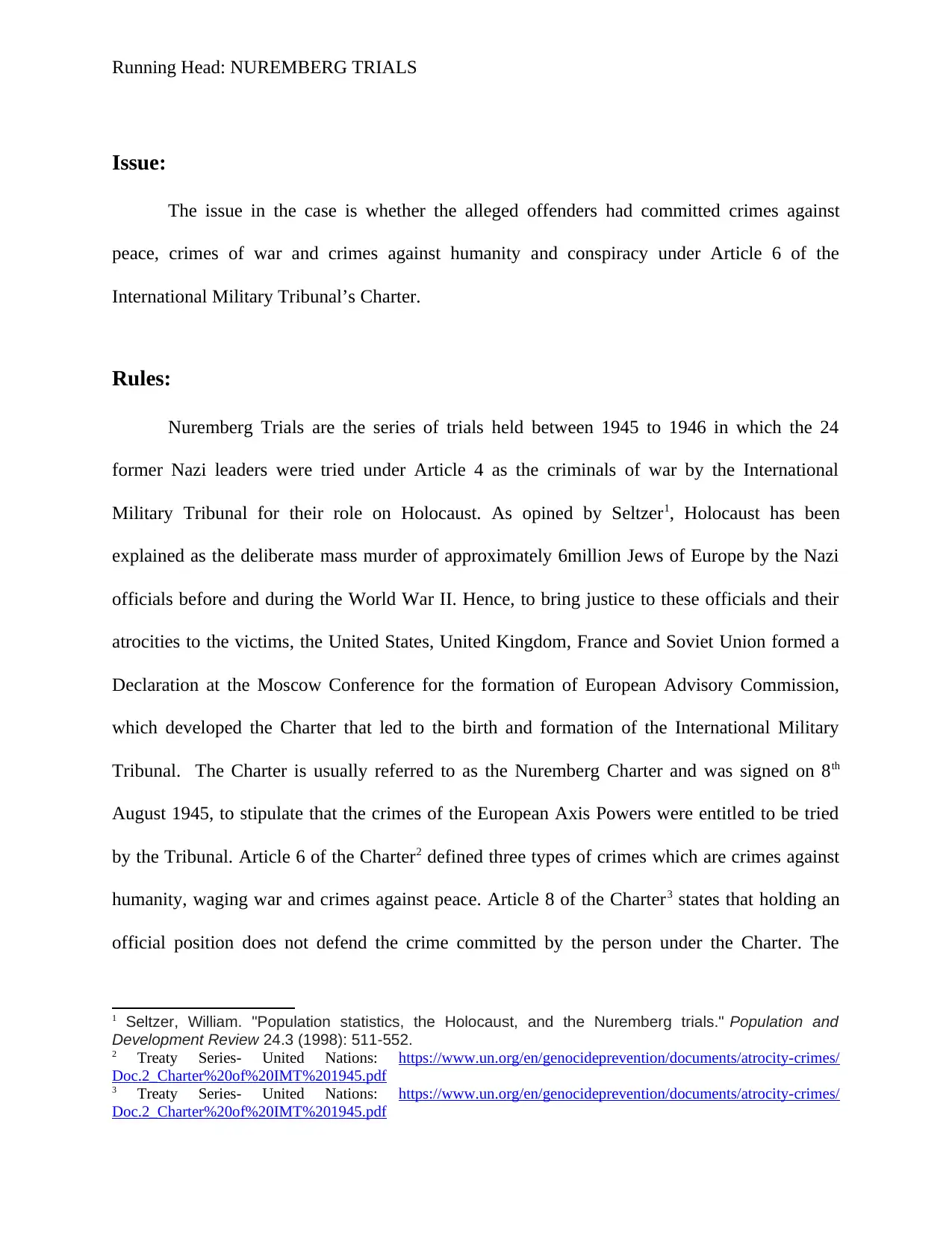
Running Head: NUREMBERG TRIALS
Issue:
The issue in the case is whether the alleged offenders had committed crimes against
peace, crimes of war and crimes against humanity and conspiracy under Article 6 of the
International Military Tribunal’s Charter.
Rules:
Nuremberg Trials are the series of trials held between 1945 to 1946 in which the 24
former Nazi leaders were tried under Article 4 as the criminals of war by the International
Military Tribunal for their role on Holocaust. As opined by Seltzer1, Holocaust has been
explained as the deliberate mass murder of approximately 6million Jews of Europe by the Nazi
officials before and during the World War II. Hence, to bring justice to these officials and their
atrocities to the victims, the United States, United Kingdom, France and Soviet Union formed a
Declaration at the Moscow Conference for the formation of European Advisory Commission,
which developed the Charter that led to the birth and formation of the International Military
Tribunal. The Charter is usually referred to as the Nuremberg Charter and was signed on 8th
August 1945, to stipulate that the crimes of the European Axis Powers were entitled to be tried
by the Tribunal. Article 6 of the Charter2 defined three types of crimes which are crimes against
humanity, waging war and crimes against peace. Article 8 of the Charter3 states that holding an
official position does not defend the crime committed by the person under the Charter. The
1 Seltzer, William. "Population statistics, the Holocaust, and the Nuremberg trials." Population and
Development Review 24.3 (1998): 511-552.
2 Treaty Series- United Nations: https://www.un.org/en/genocideprevention/documents/atrocity-crimes/
Doc.2_Charter%20of%20IMT%201945.pdf
3 Treaty Series- United Nations: https://www.un.org/en/genocideprevention/documents/atrocity-crimes/
Doc.2_Charter%20of%20IMT%201945.pdf
Issue:
The issue in the case is whether the alleged offenders had committed crimes against
peace, crimes of war and crimes against humanity and conspiracy under Article 6 of the
International Military Tribunal’s Charter.
Rules:
Nuremberg Trials are the series of trials held between 1945 to 1946 in which the 24
former Nazi leaders were tried under Article 4 as the criminals of war by the International
Military Tribunal for their role on Holocaust. As opined by Seltzer1, Holocaust has been
explained as the deliberate mass murder of approximately 6million Jews of Europe by the Nazi
officials before and during the World War II. Hence, to bring justice to these officials and their
atrocities to the victims, the United States, United Kingdom, France and Soviet Union formed a
Declaration at the Moscow Conference for the formation of European Advisory Commission,
which developed the Charter that led to the birth and formation of the International Military
Tribunal. The Charter is usually referred to as the Nuremberg Charter and was signed on 8th
August 1945, to stipulate that the crimes of the European Axis Powers were entitled to be tried
by the Tribunal. Article 6 of the Charter2 defined three types of crimes which are crimes against
humanity, waging war and crimes against peace. Article 8 of the Charter3 states that holding an
official position does not defend the crime committed by the person under the Charter. The
1 Seltzer, William. "Population statistics, the Holocaust, and the Nuremberg trials." Population and
Development Review 24.3 (1998): 511-552.
2 Treaty Series- United Nations: https://www.un.org/en/genocideprevention/documents/atrocity-crimes/
Doc.2_Charter%20of%20IMT%201945.pdf
3 Treaty Series- United Nations: https://www.un.org/en/genocideprevention/documents/atrocity-crimes/
Doc.2_Charter%20of%20IMT%201945.pdf
Secure Best Marks with AI Grader
Need help grading? Try our AI Grader for instant feedback on your assignments.
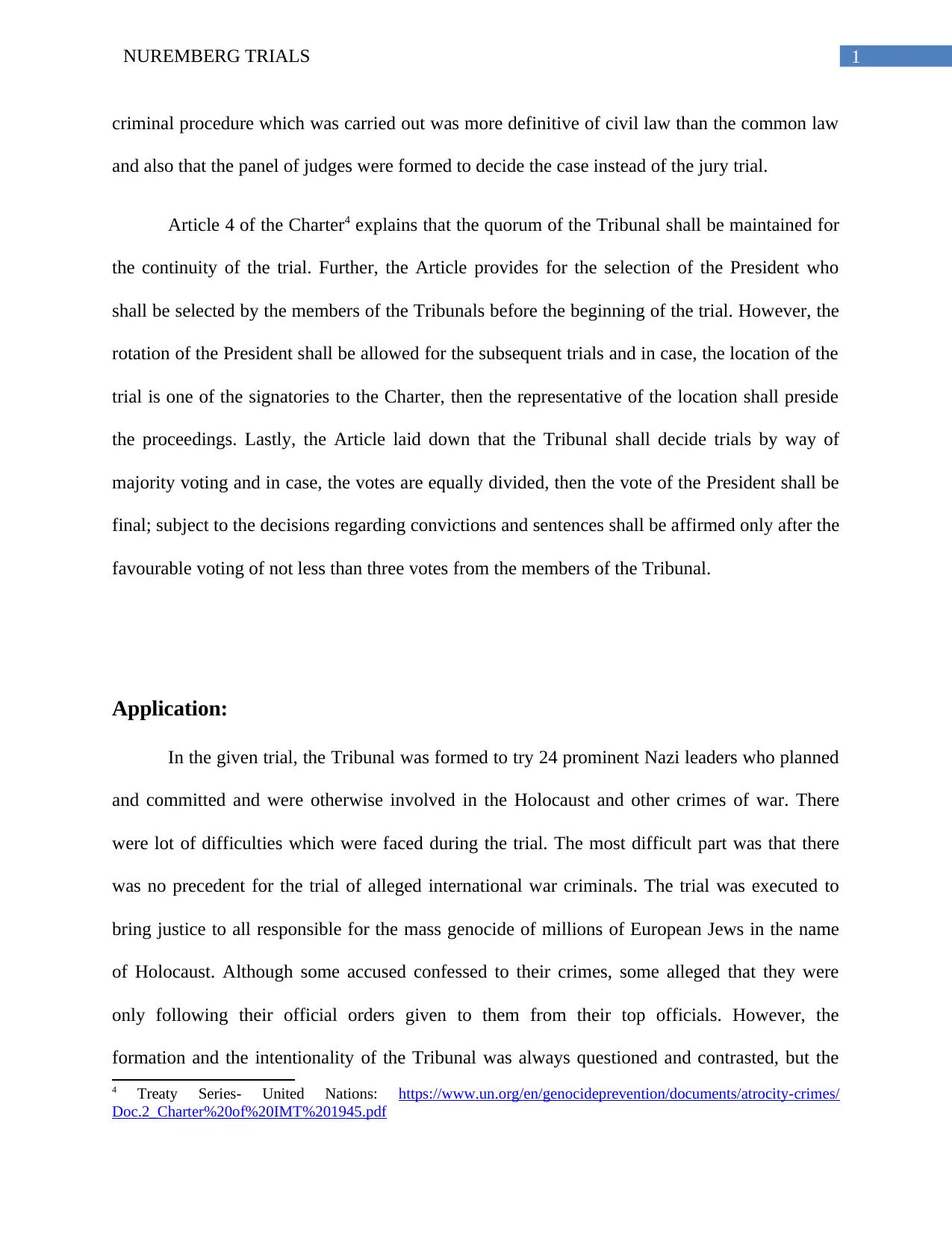
1NUREMBERG TRIALS
criminal procedure which was carried out was more definitive of civil law than the common law
and also that the panel of judges were formed to decide the case instead of the jury trial.
Article 4 of the Charter4 explains that the quorum of the Tribunal shall be maintained for
the continuity of the trial. Further, the Article provides for the selection of the President who
shall be selected by the members of the Tribunals before the beginning of the trial. However, the
rotation of the President shall be allowed for the subsequent trials and in case, the location of the
trial is one of the signatories to the Charter, then the representative of the location shall preside
the proceedings. Lastly, the Article laid down that the Tribunal shall decide trials by way of
majority voting and in case, the votes are equally divided, then the vote of the President shall be
final; subject to the decisions regarding convictions and sentences shall be affirmed only after the
favourable voting of not less than three votes from the members of the Tribunal.
Application:
In the given trial, the Tribunal was formed to try 24 prominent Nazi leaders who planned
and committed and were otherwise involved in the Holocaust and other crimes of war. There
were lot of difficulties which were faced during the trial. The most difficult part was that there
was no precedent for the trial of alleged international war criminals. The trial was executed to
bring justice to all responsible for the mass genocide of millions of European Jews in the name
of Holocaust. Although some accused confessed to their crimes, some alleged that they were
only following their official orders given to them from their top officials. However, the
formation and the intentionality of the Tribunal was always questioned and contrasted, but the
4 Treaty Series- United Nations: https://www.un.org/en/genocideprevention/documents/atrocity-crimes/
Doc.2_Charter%20of%20IMT%201945.pdf
criminal procedure which was carried out was more definitive of civil law than the common law
and also that the panel of judges were formed to decide the case instead of the jury trial.
Article 4 of the Charter4 explains that the quorum of the Tribunal shall be maintained for
the continuity of the trial. Further, the Article provides for the selection of the President who
shall be selected by the members of the Tribunals before the beginning of the trial. However, the
rotation of the President shall be allowed for the subsequent trials and in case, the location of the
trial is one of the signatories to the Charter, then the representative of the location shall preside
the proceedings. Lastly, the Article laid down that the Tribunal shall decide trials by way of
majority voting and in case, the votes are equally divided, then the vote of the President shall be
final; subject to the decisions regarding convictions and sentences shall be affirmed only after the
favourable voting of not less than three votes from the members of the Tribunal.
Application:
In the given trial, the Tribunal was formed to try 24 prominent Nazi leaders who planned
and committed and were otherwise involved in the Holocaust and other crimes of war. There
were lot of difficulties which were faced during the trial. The most difficult part was that there
was no precedent for the trial of alleged international war criminals. The trial was executed to
bring justice to all responsible for the mass genocide of millions of European Jews in the name
of Holocaust. Although some accused confessed to their crimes, some alleged that they were
only following their official orders given to them from their top officials. However, the
formation and the intentionality of the Tribunal was always questioned and contrasted, but the
4 Treaty Series- United Nations: https://www.un.org/en/genocideprevention/documents/atrocity-crimes/
Doc.2_Charter%20of%20IMT%201945.pdf
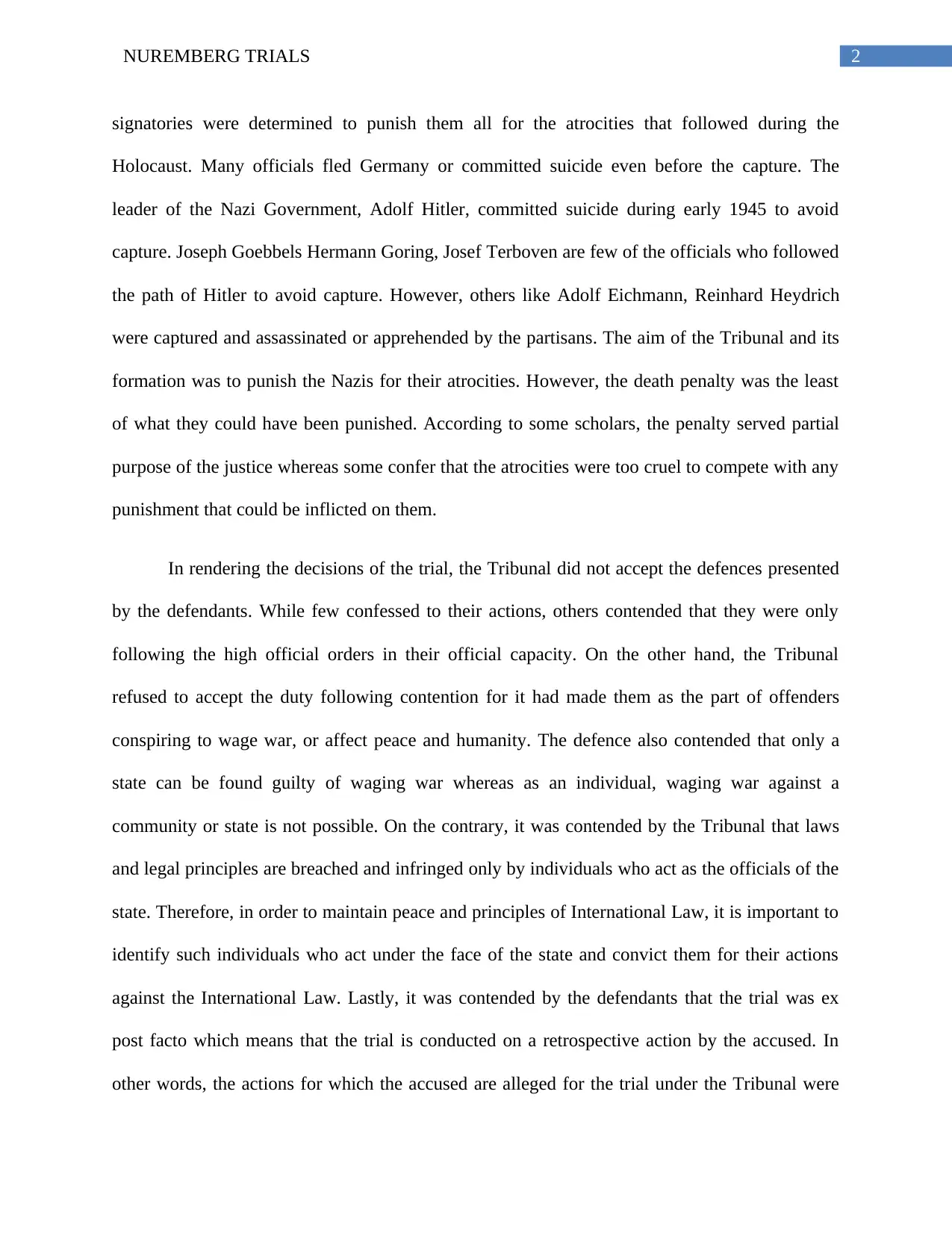
2NUREMBERG TRIALS
signatories were determined to punish them all for the atrocities that followed during the
Holocaust. Many officials fled Germany or committed suicide even before the capture. The
leader of the Nazi Government, Adolf Hitler, committed suicide during early 1945 to avoid
capture. Joseph Goebbels Hermann Goring, Josef Terboven are few of the officials who followed
the path of Hitler to avoid capture. However, others like Adolf Eichmann, Reinhard Heydrich
were captured and assassinated or apprehended by the partisans. The aim of the Tribunal and its
formation was to punish the Nazis for their atrocities. However, the death penalty was the least
of what they could have been punished. According to some scholars, the penalty served partial
purpose of the justice whereas some confer that the atrocities were too cruel to compete with any
punishment that could be inflicted on them.
In rendering the decisions of the trial, the Tribunal did not accept the defences presented
by the defendants. While few confessed to their actions, others contended that they were only
following the high official orders in their official capacity. On the other hand, the Tribunal
refused to accept the duty following contention for it had made them as the part of offenders
conspiring to wage war, or affect peace and humanity. The defence also contended that only a
state can be found guilty of waging war whereas as an individual, waging war against a
community or state is not possible. On the contrary, it was contended by the Tribunal that laws
and legal principles are breached and infringed only by individuals who act as the officials of the
state. Therefore, in order to maintain peace and principles of International Law, it is important to
identify such individuals who act under the face of the state and convict them for their actions
against the International Law. Lastly, it was contended by the defendants that the trial was ex
post facto which means that the trial is conducted on a retrospective action by the accused. In
other words, the actions for which the accused are alleged for the trial under the Tribunal were
signatories were determined to punish them all for the atrocities that followed during the
Holocaust. Many officials fled Germany or committed suicide even before the capture. The
leader of the Nazi Government, Adolf Hitler, committed suicide during early 1945 to avoid
capture. Joseph Goebbels Hermann Goring, Josef Terboven are few of the officials who followed
the path of Hitler to avoid capture. However, others like Adolf Eichmann, Reinhard Heydrich
were captured and assassinated or apprehended by the partisans. The aim of the Tribunal and its
formation was to punish the Nazis for their atrocities. However, the death penalty was the least
of what they could have been punished. According to some scholars, the penalty served partial
purpose of the justice whereas some confer that the atrocities were too cruel to compete with any
punishment that could be inflicted on them.
In rendering the decisions of the trial, the Tribunal did not accept the defences presented
by the defendants. While few confessed to their actions, others contended that they were only
following the high official orders in their official capacity. On the other hand, the Tribunal
refused to accept the duty following contention for it had made them as the part of offenders
conspiring to wage war, or affect peace and humanity. The defence also contended that only a
state can be found guilty of waging war whereas as an individual, waging war against a
community or state is not possible. On the contrary, it was contended by the Tribunal that laws
and legal principles are breached and infringed only by individuals who act as the officials of the
state. Therefore, in order to maintain peace and principles of International Law, it is important to
identify such individuals who act under the face of the state and convict them for their actions
against the International Law. Lastly, it was contended by the defendants that the trial was ex
post facto which means that the trial is conducted on a retrospective action by the accused. In
other words, the actions for which the accused are alleged for the trial under the Tribunal were
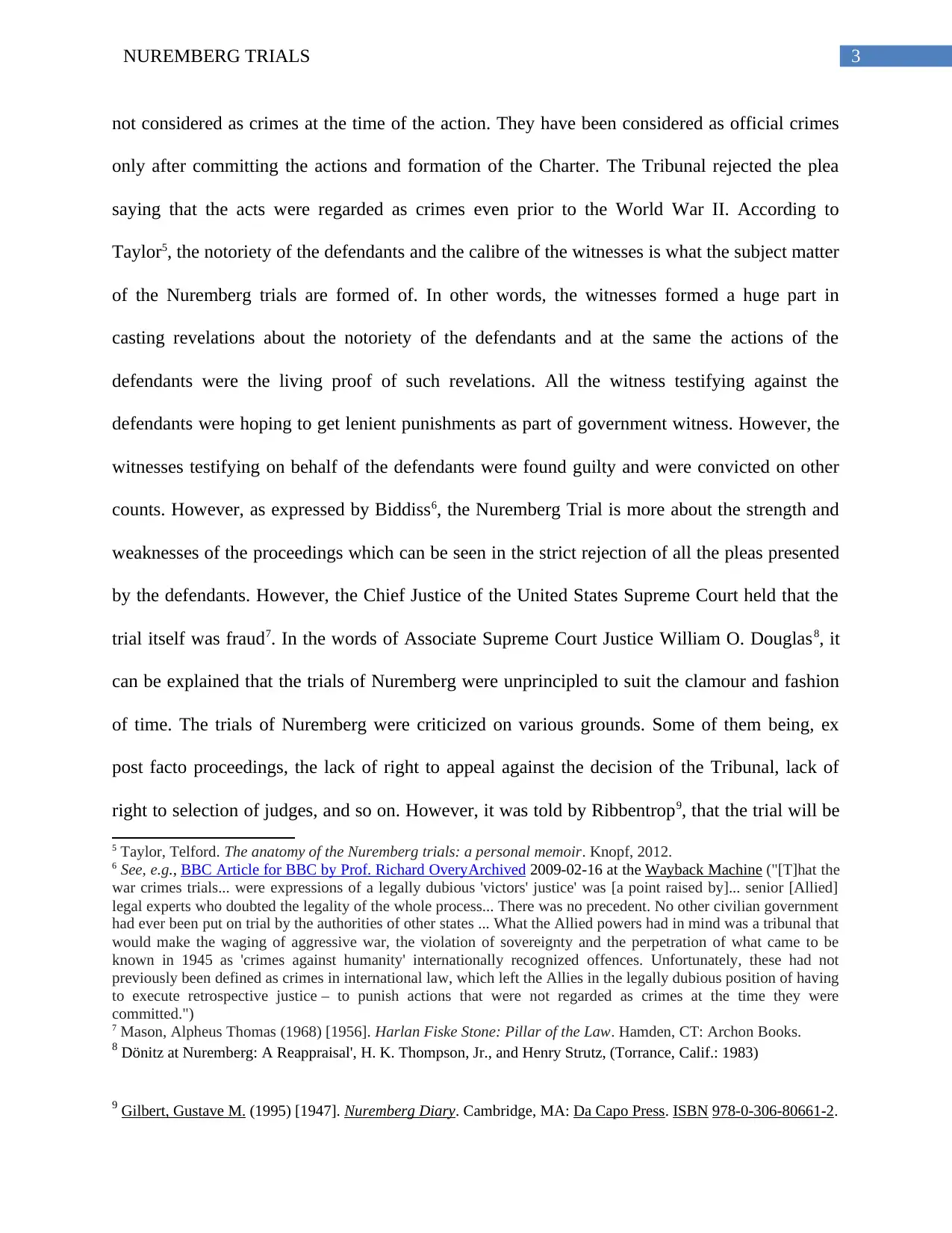
3NUREMBERG TRIALS
not considered as crimes at the time of the action. They have been considered as official crimes
only after committing the actions and formation of the Charter. The Tribunal rejected the plea
saying that the acts were regarded as crimes even prior to the World War II. According to
Taylor5, the notoriety of the defendants and the calibre of the witnesses is what the subject matter
of the Nuremberg trials are formed of. In other words, the witnesses formed a huge part in
casting revelations about the notoriety of the defendants and at the same the actions of the
defendants were the living proof of such revelations. All the witness testifying against the
defendants were hoping to get lenient punishments as part of government witness. However, the
witnesses testifying on behalf of the defendants were found guilty and were convicted on other
counts. However, as expressed by Biddiss6, the Nuremberg Trial is more about the strength and
weaknesses of the proceedings which can be seen in the strict rejection of all the pleas presented
by the defendants. However, the Chief Justice of the United States Supreme Court held that the
trial itself was fraud7. In the words of Associate Supreme Court Justice William O. Douglas8, it
can be explained that the trials of Nuremberg were unprincipled to suit the clamour and fashion
of time. The trials of Nuremberg were criticized on various grounds. Some of them being, ex
post facto proceedings, the lack of right to appeal against the decision of the Tribunal, lack of
right to selection of judges, and so on. However, it was told by Ribbentrop9, that the trial will be
5 Taylor, Telford. The anatomy of the Nuremberg trials: a personal memoir. Knopf, 2012.
6 See, e.g., BBC Article for BBC by Prof. Richard OveryArchived 2009-02-16 at the Wayback Machine ("[T]hat the
war crimes trials... were expressions of a legally dubious 'victors' justice' was [a point raised by]... senior [Allied]
legal experts who doubted the legality of the whole process... There was no precedent. No other civilian government
had ever been put on trial by the authorities of other states ... What the Allied powers had in mind was a tribunal that
would make the waging of aggressive war, the violation of sovereignty and the perpetration of what came to be
known in 1945 as 'crimes against humanity' internationally recognized offences. Unfortunately, these had not
previously been defined as crimes in international law, which left the Allies in the legally dubious position of having
to execute retrospective justice – to punish actions that were not regarded as crimes at the time they were
committed.")
7 Mason, Alpheus Thomas (1968) [1956]. Harlan Fiske Stone: Pillar of the Law. Hamden, CT: Archon Books.
8 Dönitz at Nuremberg: A Reappraisal', H. K. Thompson, Jr., and Henry Strutz, (Torrance, Calif.: 1983)
9 Gilbert, Gustave M. (1995) [1947]. Nuremberg Diary. Cambridge, MA: Da Capo Press. ISBN 978-0-306-80661-2.
not considered as crimes at the time of the action. They have been considered as official crimes
only after committing the actions and formation of the Charter. The Tribunal rejected the plea
saying that the acts were regarded as crimes even prior to the World War II. According to
Taylor5, the notoriety of the defendants and the calibre of the witnesses is what the subject matter
of the Nuremberg trials are formed of. In other words, the witnesses formed a huge part in
casting revelations about the notoriety of the defendants and at the same the actions of the
defendants were the living proof of such revelations. All the witness testifying against the
defendants were hoping to get lenient punishments as part of government witness. However, the
witnesses testifying on behalf of the defendants were found guilty and were convicted on other
counts. However, as expressed by Biddiss6, the Nuremberg Trial is more about the strength and
weaknesses of the proceedings which can be seen in the strict rejection of all the pleas presented
by the defendants. However, the Chief Justice of the United States Supreme Court held that the
trial itself was fraud7. In the words of Associate Supreme Court Justice William O. Douglas8, it
can be explained that the trials of Nuremberg were unprincipled to suit the clamour and fashion
of time. The trials of Nuremberg were criticized on various grounds. Some of them being, ex
post facto proceedings, the lack of right to appeal against the decision of the Tribunal, lack of
right to selection of judges, and so on. However, it was told by Ribbentrop9, that the trial will be
5 Taylor, Telford. The anatomy of the Nuremberg trials: a personal memoir. Knopf, 2012.
6 See, e.g., BBC Article for BBC by Prof. Richard OveryArchived 2009-02-16 at the Wayback Machine ("[T]hat the
war crimes trials... were expressions of a legally dubious 'victors' justice' was [a point raised by]... senior [Allied]
legal experts who doubted the legality of the whole process... There was no precedent. No other civilian government
had ever been put on trial by the authorities of other states ... What the Allied powers had in mind was a tribunal that
would make the waging of aggressive war, the violation of sovereignty and the perpetration of what came to be
known in 1945 as 'crimes against humanity' internationally recognized offences. Unfortunately, these had not
previously been defined as crimes in international law, which left the Allies in the legally dubious position of having
to execute retrospective justice – to punish actions that were not regarded as crimes at the time they were
committed.")
7 Mason, Alpheus Thomas (1968) [1956]. Harlan Fiske Stone: Pillar of the Law. Hamden, CT: Archon Books.
8 Dönitz at Nuremberg: A Reappraisal', H. K. Thompson, Jr., and Henry Strutz, (Torrance, Calif.: 1983)
9 Gilbert, Gustave M. (1995) [1947]. Nuremberg Diary. Cambridge, MA: Da Capo Press. ISBN 978-0-306-80661-2.
Secure Best Marks with AI Grader
Need help grading? Try our AI Grader for instant feedback on your assignments.
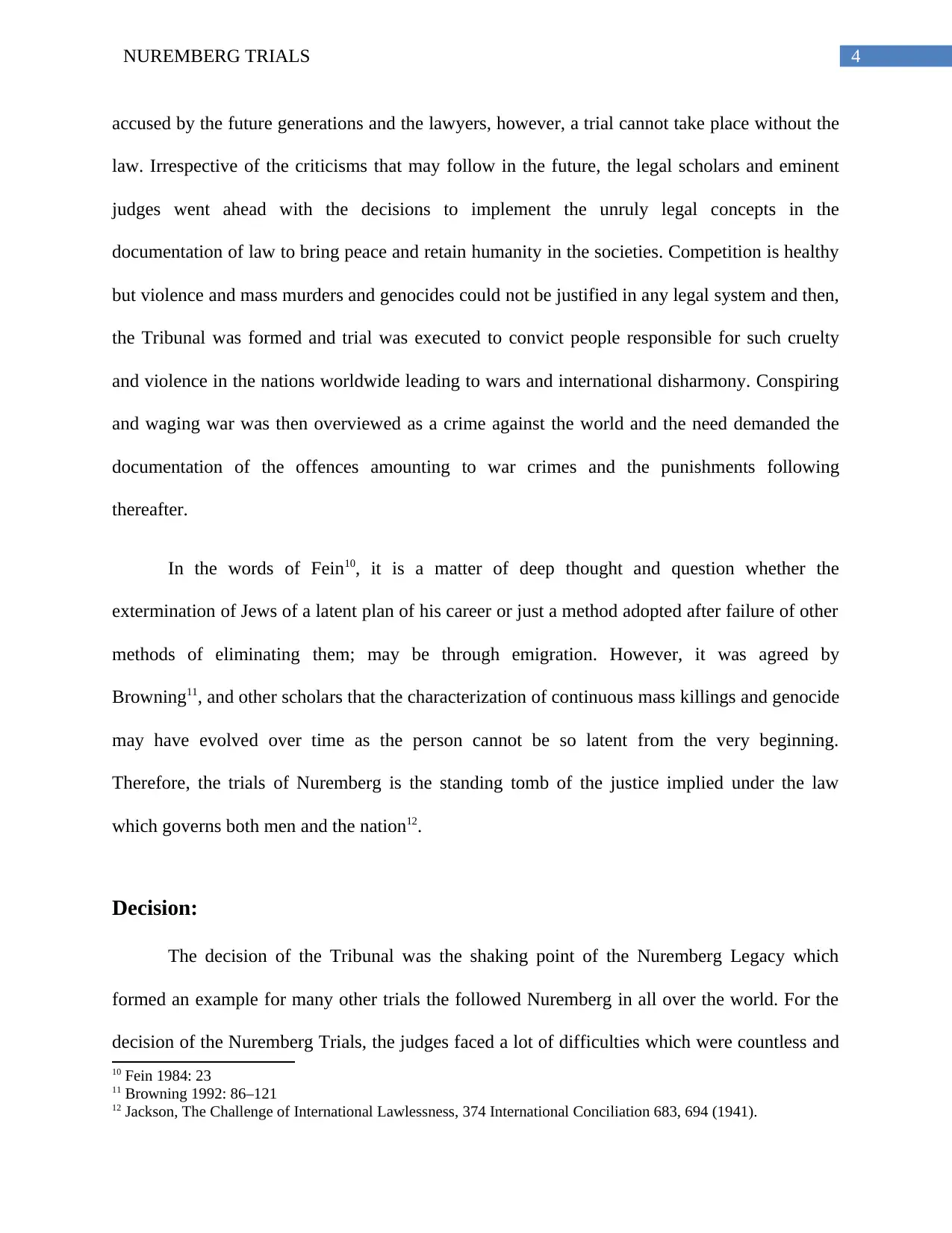
4NUREMBERG TRIALS
accused by the future generations and the lawyers, however, a trial cannot take place without the
law. Irrespective of the criticisms that may follow in the future, the legal scholars and eminent
judges went ahead with the decisions to implement the unruly legal concepts in the
documentation of law to bring peace and retain humanity in the societies. Competition is healthy
but violence and mass murders and genocides could not be justified in any legal system and then,
the Tribunal was formed and trial was executed to convict people responsible for such cruelty
and violence in the nations worldwide leading to wars and international disharmony. Conspiring
and waging war was then overviewed as a crime against the world and the need demanded the
documentation of the offences amounting to war crimes and the punishments following
thereafter.
In the words of Fein10, it is a matter of deep thought and question whether the
extermination of Jews of a latent plan of his career or just a method adopted after failure of other
methods of eliminating them; may be through emigration. However, it was agreed by
Browning11, and other scholars that the characterization of continuous mass killings and genocide
may have evolved over time as the person cannot be so latent from the very beginning.
Therefore, the trials of Nuremberg is the standing tomb of the justice implied under the law
which governs both men and the nation12.
Decision:
The decision of the Tribunal was the shaking point of the Nuremberg Legacy which
formed an example for many other trials the followed Nuremberg in all over the world. For the
decision of the Nuremberg Trials, the judges faced a lot of difficulties which were countless and
10 Fein 1984: 23
11 Browning 1992: 86–121
12 Jackson, The Challenge of International Lawlessness, 374 International Conciliation 683, 694 (1941).
accused by the future generations and the lawyers, however, a trial cannot take place without the
law. Irrespective of the criticisms that may follow in the future, the legal scholars and eminent
judges went ahead with the decisions to implement the unruly legal concepts in the
documentation of law to bring peace and retain humanity in the societies. Competition is healthy
but violence and mass murders and genocides could not be justified in any legal system and then,
the Tribunal was formed and trial was executed to convict people responsible for such cruelty
and violence in the nations worldwide leading to wars and international disharmony. Conspiring
and waging war was then overviewed as a crime against the world and the need demanded the
documentation of the offences amounting to war crimes and the punishments following
thereafter.
In the words of Fein10, it is a matter of deep thought and question whether the
extermination of Jews of a latent plan of his career or just a method adopted after failure of other
methods of eliminating them; may be through emigration. However, it was agreed by
Browning11, and other scholars that the characterization of continuous mass killings and genocide
may have evolved over time as the person cannot be so latent from the very beginning.
Therefore, the trials of Nuremberg is the standing tomb of the justice implied under the law
which governs both men and the nation12.
Decision:
The decision of the Tribunal was the shaking point of the Nuremberg Legacy which
formed an example for many other trials the followed Nuremberg in all over the world. For the
decision of the Nuremberg Trials, the judges faced a lot of difficulties which were countless and
10 Fein 1984: 23
11 Browning 1992: 86–121
12 Jackson, The Challenge of International Lawlessness, 374 International Conciliation 683, 694 (1941).
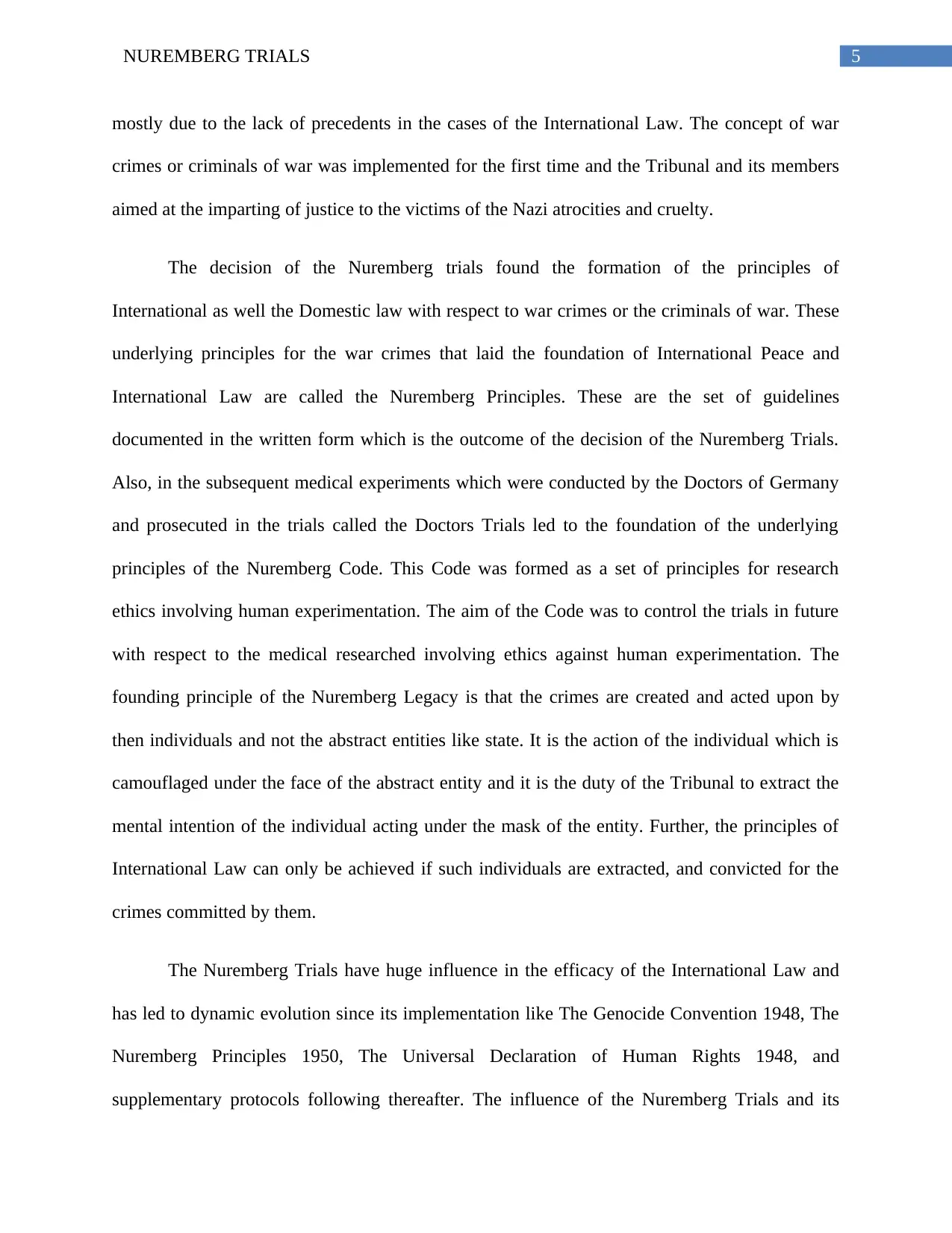
5NUREMBERG TRIALS
mostly due to the lack of precedents in the cases of the International Law. The concept of war
crimes or criminals of war was implemented for the first time and the Tribunal and its members
aimed at the imparting of justice to the victims of the Nazi atrocities and cruelty.
The decision of the Nuremberg trials found the formation of the principles of
International as well the Domestic law with respect to war crimes or the criminals of war. These
underlying principles for the war crimes that laid the foundation of International Peace and
International Law are called the Nuremberg Principles. These are the set of guidelines
documented in the written form which is the outcome of the decision of the Nuremberg Trials.
Also, in the subsequent medical experiments which were conducted by the Doctors of Germany
and prosecuted in the trials called the Doctors Trials led to the foundation of the underlying
principles of the Nuremberg Code. This Code was formed as a set of principles for research
ethics involving human experimentation. The aim of the Code was to control the trials in future
with respect to the medical researched involving ethics against human experimentation. The
founding principle of the Nuremberg Legacy is that the crimes are created and acted upon by
then individuals and not the abstract entities like state. It is the action of the individual which is
camouflaged under the face of the abstract entity and it is the duty of the Tribunal to extract the
mental intention of the individual acting under the mask of the entity. Further, the principles of
International Law can only be achieved if such individuals are extracted, and convicted for the
crimes committed by them.
The Nuremberg Trials have huge influence in the efficacy of the International Law and
has led to dynamic evolution since its implementation like The Genocide Convention 1948, The
Nuremberg Principles 1950, The Universal Declaration of Human Rights 1948, and
supplementary protocols following thereafter. The influence of the Nuremberg Trials and its
mostly due to the lack of precedents in the cases of the International Law. The concept of war
crimes or criminals of war was implemented for the first time and the Tribunal and its members
aimed at the imparting of justice to the victims of the Nazi atrocities and cruelty.
The decision of the Nuremberg trials found the formation of the principles of
International as well the Domestic law with respect to war crimes or the criminals of war. These
underlying principles for the war crimes that laid the foundation of International Peace and
International Law are called the Nuremberg Principles. These are the set of guidelines
documented in the written form which is the outcome of the decision of the Nuremberg Trials.
Also, in the subsequent medical experiments which were conducted by the Doctors of Germany
and prosecuted in the trials called the Doctors Trials led to the foundation of the underlying
principles of the Nuremberg Code. This Code was formed as a set of principles for research
ethics involving human experimentation. The aim of the Code was to control the trials in future
with respect to the medical researched involving ethics against human experimentation. The
founding principle of the Nuremberg Legacy is that the crimes are created and acted upon by
then individuals and not the abstract entities like state. It is the action of the individual which is
camouflaged under the face of the abstract entity and it is the duty of the Tribunal to extract the
mental intention of the individual acting under the mask of the entity. Further, the principles of
International Law can only be achieved if such individuals are extracted, and convicted for the
crimes committed by them.
The Nuremberg Trials have huge influence in the efficacy of the International Law and
has led to dynamic evolution since its implementation like The Genocide Convention 1948, The
Nuremberg Principles 1950, The Universal Declaration of Human Rights 1948, and
supplementary protocols following thereafter. The influence of the Nuremberg Trials and its
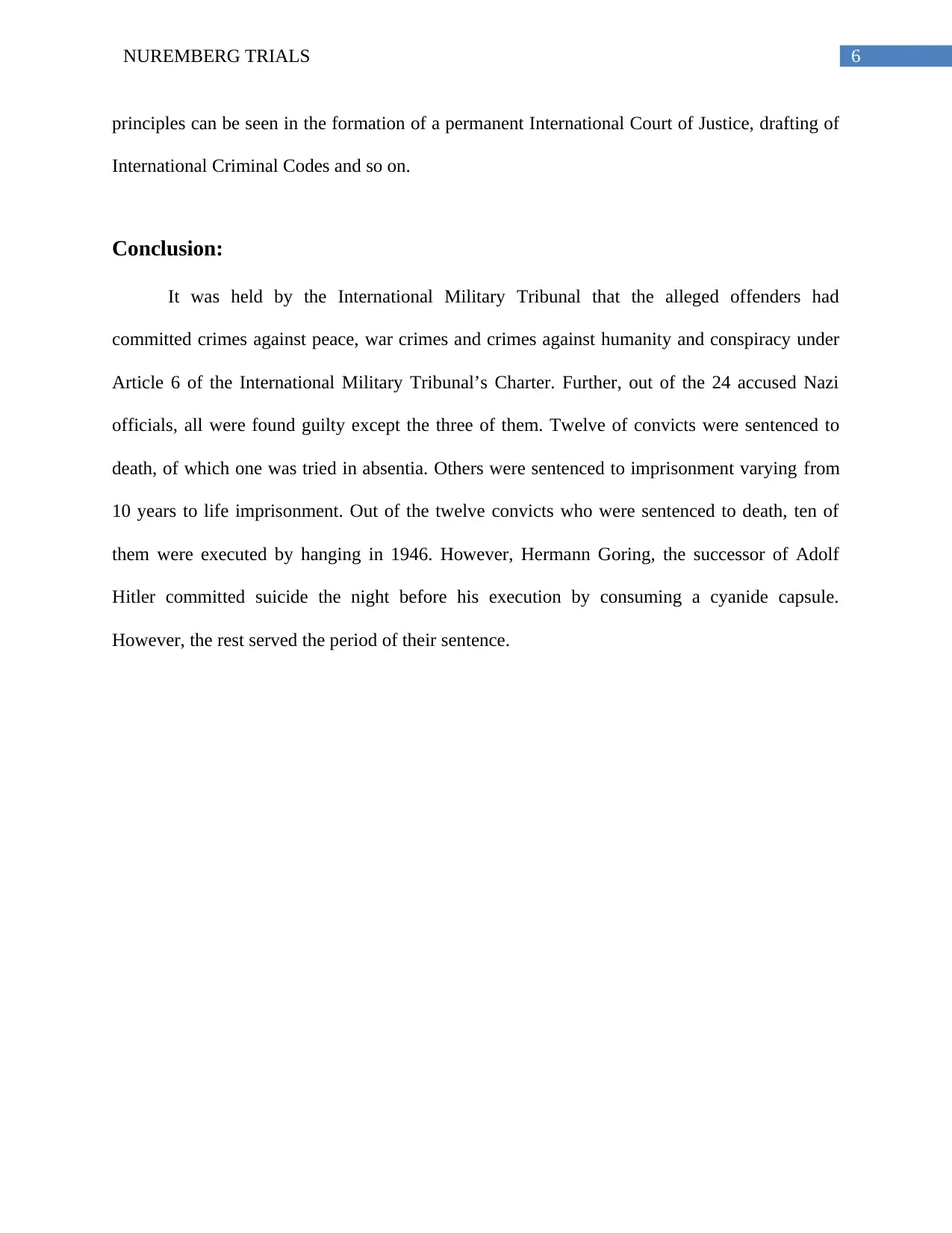
6NUREMBERG TRIALS
principles can be seen in the formation of a permanent International Court of Justice, drafting of
International Criminal Codes and so on.
Conclusion:
It was held by the International Military Tribunal that the alleged offenders had
committed crimes against peace, war crimes and crimes against humanity and conspiracy under
Article 6 of the International Military Tribunal’s Charter. Further, out of the 24 accused Nazi
officials, all were found guilty except the three of them. Twelve of convicts were sentenced to
death, of which one was tried in absentia. Others were sentenced to imprisonment varying from
10 years to life imprisonment. Out of the twelve convicts who were sentenced to death, ten of
them were executed by hanging in 1946. However, Hermann Goring, the successor of Adolf
Hitler committed suicide the night before his execution by consuming a cyanide capsule.
However, the rest served the period of their sentence.
principles can be seen in the formation of a permanent International Court of Justice, drafting of
International Criminal Codes and so on.
Conclusion:
It was held by the International Military Tribunal that the alleged offenders had
committed crimes against peace, war crimes and crimes against humanity and conspiracy under
Article 6 of the International Military Tribunal’s Charter. Further, out of the 24 accused Nazi
officials, all were found guilty except the three of them. Twelve of convicts were sentenced to
death, of which one was tried in absentia. Others were sentenced to imprisonment varying from
10 years to life imprisonment. Out of the twelve convicts who were sentenced to death, ten of
them were executed by hanging in 1946. However, Hermann Goring, the successor of Adolf
Hitler committed suicide the night before his execution by consuming a cyanide capsule.
However, the rest served the period of their sentence.
Paraphrase This Document
Need a fresh take? Get an instant paraphrase of this document with our AI Paraphraser
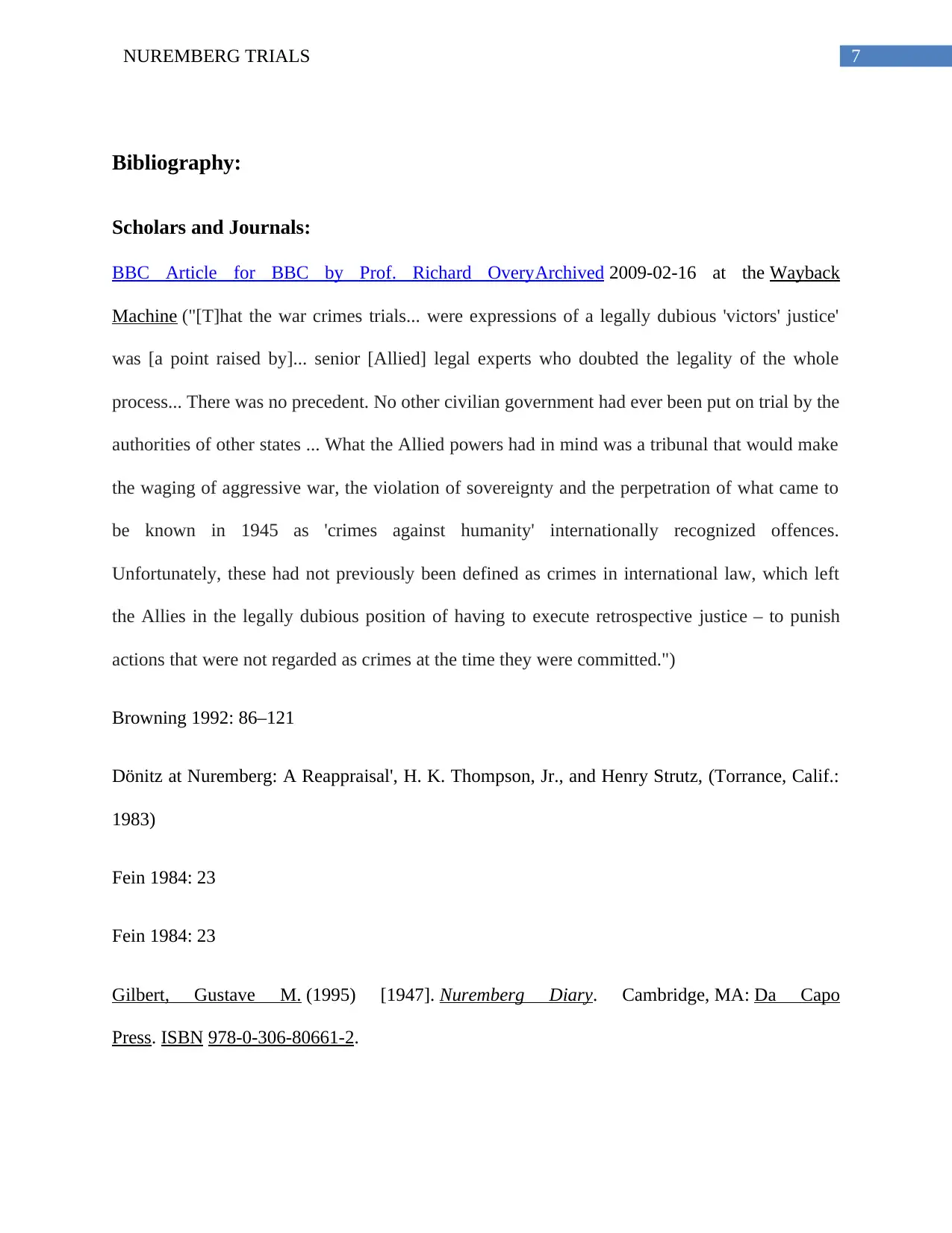
7NUREMBERG TRIALS
Bibliography:
Scholars and Journals:
BBC Article for BBC by Prof. Richard OveryArchived 2009-02-16 at the Wayback
Machine ("[T]hat the war crimes trials... were expressions of a legally dubious 'victors' justice'
was [a point raised by]... senior [Allied] legal experts who doubted the legality of the whole
process... There was no precedent. No other civilian government had ever been put on trial by the
authorities of other states ... What the Allied powers had in mind was a tribunal that would make
the waging of aggressive war, the violation of sovereignty and the perpetration of what came to
be known in 1945 as 'crimes against humanity' internationally recognized offences.
Unfortunately, these had not previously been defined as crimes in international law, which left
the Allies in the legally dubious position of having to execute retrospective justice – to punish
actions that were not regarded as crimes at the time they were committed.")
Browning 1992: 86–121
Dönitz at Nuremberg: A Reappraisal', H. K. Thompson, Jr., and Henry Strutz, (Torrance, Calif.:
1983)
Fein 1984: 23
Fein 1984: 23
Gilbert, Gustave M. (1995) [1947]. Nuremberg Diary. Cambridge, MA: Da Capo
Press. ISBN 978-0-306-80661-2.
Bibliography:
Scholars and Journals:
BBC Article for BBC by Prof. Richard OveryArchived 2009-02-16 at the Wayback
Machine ("[T]hat the war crimes trials... were expressions of a legally dubious 'victors' justice'
was [a point raised by]... senior [Allied] legal experts who doubted the legality of the whole
process... There was no precedent. No other civilian government had ever been put on trial by the
authorities of other states ... What the Allied powers had in mind was a tribunal that would make
the waging of aggressive war, the violation of sovereignty and the perpetration of what came to
be known in 1945 as 'crimes against humanity' internationally recognized offences.
Unfortunately, these had not previously been defined as crimes in international law, which left
the Allies in the legally dubious position of having to execute retrospective justice – to punish
actions that were not regarded as crimes at the time they were committed.")
Browning 1992: 86–121
Dönitz at Nuremberg: A Reappraisal', H. K. Thompson, Jr., and Henry Strutz, (Torrance, Calif.:
1983)
Fein 1984: 23
Fein 1984: 23
Gilbert, Gustave M. (1995) [1947]. Nuremberg Diary. Cambridge, MA: Da Capo
Press. ISBN 978-0-306-80661-2.
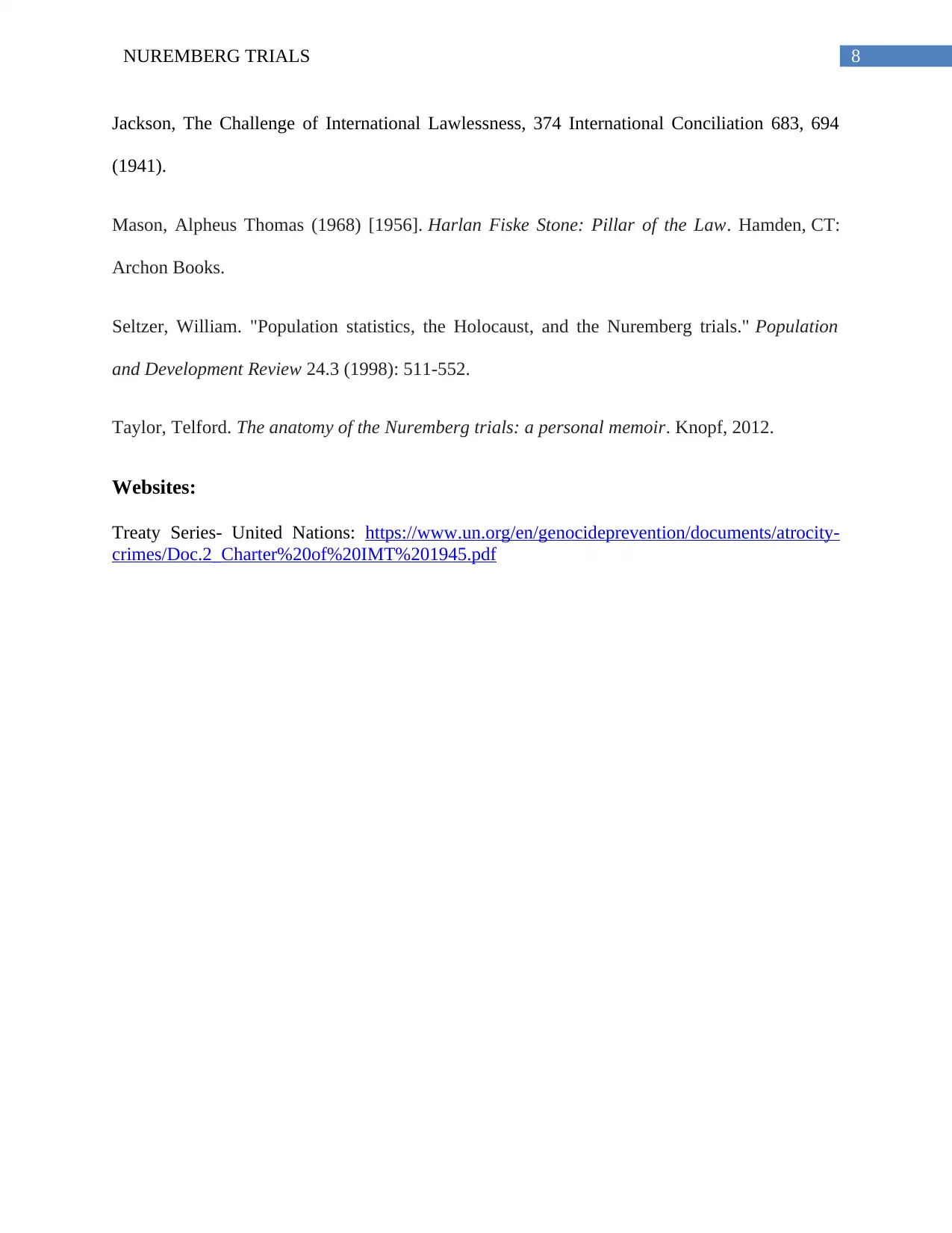
8NUREMBERG TRIALS
Jackson, The Challenge of International Lawlessness, 374 International Conciliation 683, 694
(1941).
Mason, Alpheus Thomas (1968) [1956]. Harlan Fiske Stone: Pillar of the Law. Hamden, CT:
Archon Books.
Seltzer, William. "Population statistics, the Holocaust, and the Nuremberg trials." Population
and Development Review 24.3 (1998): 511-552.
Taylor, Telford. The anatomy of the Nuremberg trials: a personal memoir. Knopf, 2012.
Websites:
Treaty Series- United Nations: https://www.un.org/en/genocideprevention/documents/atrocity-
crimes/Doc.2_Charter%20of%20IMT%201945.pdf
Jackson, The Challenge of International Lawlessness, 374 International Conciliation 683, 694
(1941).
Mason, Alpheus Thomas (1968) [1956]. Harlan Fiske Stone: Pillar of the Law. Hamden, CT:
Archon Books.
Seltzer, William. "Population statistics, the Holocaust, and the Nuremberg trials." Population
and Development Review 24.3 (1998): 511-552.
Taylor, Telford. The anatomy of the Nuremberg trials: a personal memoir. Knopf, 2012.
Websites:
Treaty Series- United Nations: https://www.un.org/en/genocideprevention/documents/atrocity-
crimes/Doc.2_Charter%20of%20IMT%201945.pdf
1 out of 9
Related Documents
Your All-in-One AI-Powered Toolkit for Academic Success.
+13062052269
info@desklib.com
Available 24*7 on WhatsApp / Email
![[object Object]](/_next/static/media/star-bottom.7253800d.svg)
Unlock your academic potential
© 2024 | Zucol Services PVT LTD | All rights reserved.




